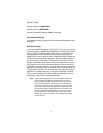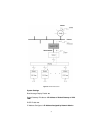32
Remote IP Address: <IP Address of Software App. Host>
Remote Port: <TCP Port Number of Software App. Host>
Remote Password: UNDEFINED (or required setting)
Remote User ID: UNDEFINED (or required setting)
Session Termination Character: 0x04 (or preferred)
User Database Settings
user database empty! (or add users and corresponding passwords and
privileges)
PPP Operation
In the typical PPP application (see Figure 8), the user has a need to
remotely connect to a LAN for general access to the LAN (e-mail, appli-
cations, etc.) or for access to the Internet. To make this connection, the
user typically uses a dial-up modem with standard POTS line and
launches a PPP application to connect with a dial-up (or ISDN) modem
connected to the LAN. Once the connection is made between the PPP
dial-up peer and the modem, the Model 2120 serial interface will typically
obtain its operating IP address from an active DHCP server on the LAN
and then establishes a connection with the LAN. Once connected to the
LAN, the user is typically prompted to enter a user name and password
through the enabling of PAP user authentication protocol. When the cor-
rect user name and password are entered, the user is permitted access
to the LAN for general or Internet access. The data from the PPP appli-
cation and LAN is converted into PPP packets and the data is moved
back and forth through the established PPP connection and over the
LAN. For domain name resolution, the Model 2120 is typically config-
ured for DNS with the addresses of a primary and secondary DNS. In
this type of application, the PPP connection is usually terminated once
the user is finished accessing the LAN/Internet.


















